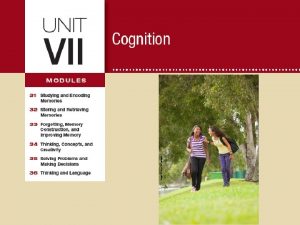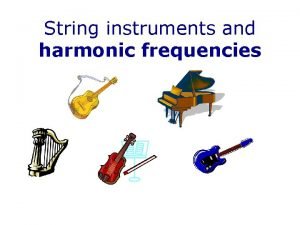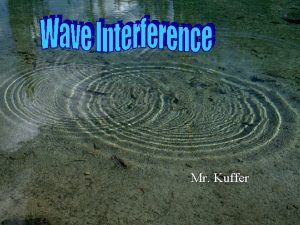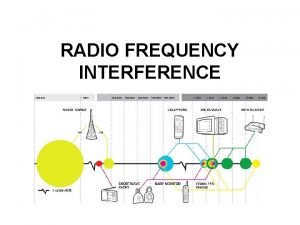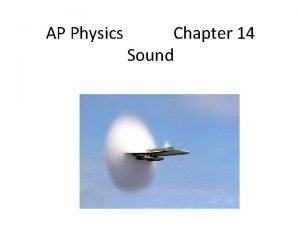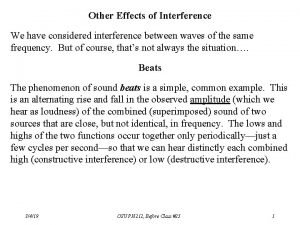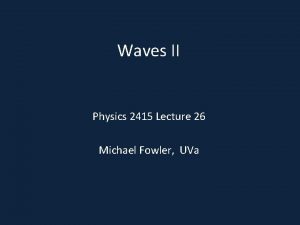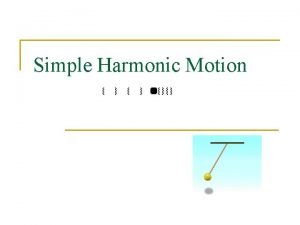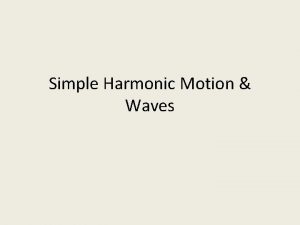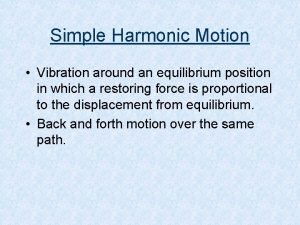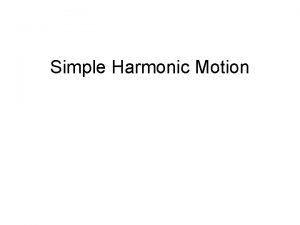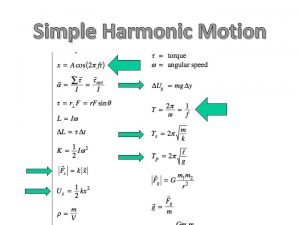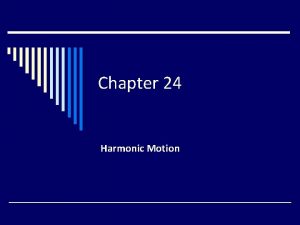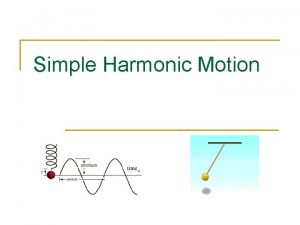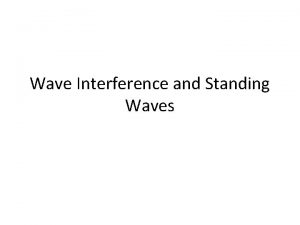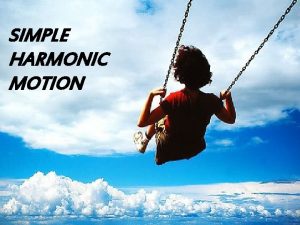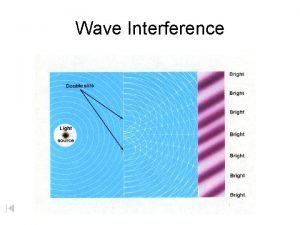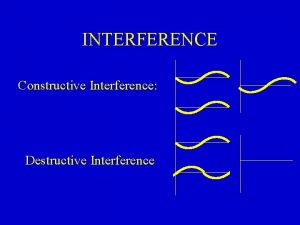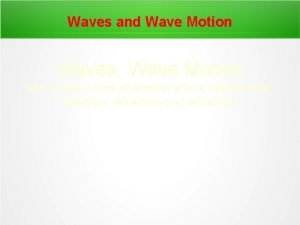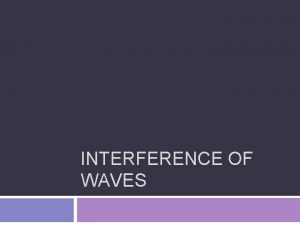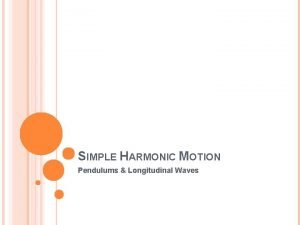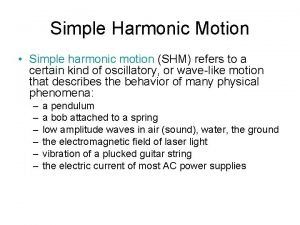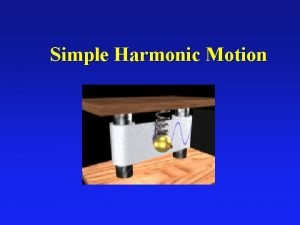Waves Harmonic Motion Wave Types Wave Speed Interference















- Slides: 15

Waves Harmonic Motion, Wave Types, Wave Speed, Interference

Simple Harmonic • Amplitude – How high the pendulum Motion - Pendulum goes or begins with. • Period – The time it takes to make one complete revolution. • Frequency=1/period. Measured in Hertz or hz. • Physics Simulation

Harmonic Motion Questions You are designing a pendulum clock to have a period of 1. 0 s. How long should the pendulum be? • A simple pendulum swings in simple harmonic motion. At maximum displacement, a. the acceleration reaches a maximum. b. the velocity reaches a maximum. ANS: A c. the acceleration reaches zero. d. the restoring forces reach zero. • Which of the following is the number of cycles or vibrations per unit of time? a. amplitude b. period c. frequency d. revolution ANS: C • An amusement park ride has a frequency of 0. 05 Hz. What is the ride’s period? a. 5 s b. l 0 s ANS: C c. 20 s d. 40 s

Properties of waves • A wave is the motion of a disturbance • Waves that require a material medium are called mechanical waves. • A wave whose source vibrates with simple harmonic motion is called a sine wave. • Vibrations of a transverse wave are perpendicular to the wave motion • Vibrations of a longitudinal wave are parallel to the wave motion • Wave speed equals frequency times wavelength • Waves transfer energy - When the amplitude of a mechanical wave is doubled, the energy it carries in a given time interval increases by a factor of four. • Physics Simulation

Electromagnetic Waves • Electromagnetic waves vary depending on frequency and wavelength. • EM waves travel through a vacuum. • All electromagnetic waves move at the speed of light or c = 3. 00 x 108 m/s (square-root of electric constant divided by magnetic constant). • ROYGBIV (red, orange, yellow, green, blue, indigo, violet) – Visible Light Spectrum between 400 nm and 700 nm.

Properties of waves Questions 1 • The speed of all electromagnetic waves in empty space is 3. 00 x 108 m/s. Calculate the wavelength of electromagnetic waves emitted at the following frequencies: • a. radio waves at 88. 0 MHz • b. visible light at 6. 0 x 108 MHz • c. Xrays at 3. 0 x 1012 MHz

Properties of waves Questions 2 • Which of the following is a wave whose source is some form of repeating motion? a. pulse wave b. periodic wave ANS: B c. sine wave d. transverse wave • One end of a taut rope is fixed to a post. What type of wave is demonstrated if the free end is quickly raised and lowered? a. pulse wave c. sine wave b. periodic wave d. transverse wave ANS: A • What happens to the energy carried in a given time interval by a mechanical wave when the wave’s amplitude is doubled? a. It increases by a factor of two. c. It decreases by a factor of two. b. It increases by a factor of four. d. It decreases by a factor of four. ANS: B

Wave interactions • Because mechanical waves are not matter but rather are displacements of matter, two waves can occupy the same space at the same time. The combination of two overlapping waves is called superposition. • Displacements in the same direction produce constructive interference • Displacements in opposite directions produce destructive interference • At a free boundary, waves are reflected. Reflected pulse is identical to incident pulse • At a fixed boundary, waves are reflected and inverted – Reflected pulse is inverted pattern • A standing wave consists of alternating regions of constructive and destructive interference. • Physics Simulation

Standing waves have nodes and antinodes When a wave reaches a boundary, some of the wave is usually reflected back into the original medium. If a wave in a medium reaches a boundary it can't travel through the entire wave is reflected (the energy has to go somewhere). The reflected wave will interfere with the incident wave. If the entire wave is reflected back, a standing wave is produced. The standing wave pattern consists of a series of nodes, where the two waves cancel out completely, and anti-nodes, where they add constructively.

Wave Interactions Questions The superposition of mechanical waves can be observed in the movement of a. bumper cars. b. waves in a ripple tank. ANS: B c. electromagnetic radiation. d. an orchestra. Which of the following is the interference that results when individual displacements on opposite sides of the equilibrium position are added together to form the resultant wave? a. constructive c. complete constructive b. destructive d. complete destructive ANS: B DIP: I OBJ: 12 -4. 2 Consider two identical wave pulses on a rope. Suppose the first pulse reaches the fixed end of the rope, is reflected back, and then meets the second pulse. The superposition principle predicts that the amplitude of the resultant pulses at that moment will be what factor times the amplitude of one of the original pulses? a. 0 b. 1 ANS: A c. 2 d. 4 At a fixed boundary, waves are a. neither reflected nor inverted. b. reflected but not inverted. ANS: C c. reflected and inverted. d. inverted but not reflected. How many nodes and antinodes are shown in the standing wave above? a. two nodes and three antinodes b. one node and two antinodes ANS: D c. one-third node and one antinode d. three nodes and two antinodes A 3. 0 m long stretched string is fixed at both ends. If standing waves with a wavelength of two-thirds L are produced on this string, how many nodes will be formed? a. 0 c. 3 b. 2 d. 4 ANS: D

Sound Waves • Sound waves are longitudinal • Sound waves with frequencies less than 20 Hz are called infrasonic waves, and those above 20 000 Hz are called ultrasonic waves. • Sound waves that the average human ear can hear, called audible sound waves, have frequencies between 20 and 20 000 Hz. • Frequency determines pitch • Speed of sound depends on the medium • Sound waves propagate in three dimensions • Intensity is the rate of energy flow through a given area • The rate at which this energy is transferred through a unit area of the plane wave is called the intensity of the wave, • Intensity has units of watts per squaremeter (W/m 2) or decibels. • The volume doubles every 10 decibels • Physics Simulation

• The Doppler Effect Relative motion creates a change in frequency. • If you stand on the street while someone drives by honking a car horn, you will notice the pitch of the horn change. The pitch will be higher as the car approaches and will be lower as the car moves away.

Sound Waves Questions Bats can detect small objects, such as insects, that are approximately the size of one wavelength. If a bat emits a chirp at a frequency of 60. 0 k. Hz and the speed of sound waves in air is 330 m/s, what is the size of the smallest insect that the bat can detect? a. 1. 5 mm c. 5. 5 mm b. 3. 5 mm d. 7. 5 mm ANS: C Sound waves a. are a part of the electromagnetic spectrum. b. do not require a medium for transmission. c. are longitudinal waves. d. are transverse waves. ANS: C Which of the following is the number of cycles per unit of time? a. infrasonic wave c. ultrasonic wave b. frequency d. wavelength ANS: B

Which of the following has a higher speed of sound? a. helium at 0°C c. copper at 0°C b. air at 0°C d. air at 100°C As a train starts from rest then accelerates down the track, coming toward an observer faster and faster, the frequency of the sound waves coming toward the observer will be a. less than the source frequency. c. stationary. b. constantly increasing in frequency. d. greater than the source frequency. ANS: B If the intensity of a sound is increased by a factor of 100, the new decibel level will be a. two units greater. c. 10 times greater. b. double the old one. d. 20 units greater. ANS: D

Citations • Holt Physics 2000.
 Periodic motion formula
Periodic motion formula What is proactive and retroactive interference
What is proactive and retroactive interference Proactive interference vs retroactive interference
Proactive interference vs retroactive interference Wave
Wave Constructive interference of standing waves
Constructive interference of standing waves Draw the interference pattern for the two waves
Draw the interference pattern for the two waves Rf interference
Rf interference Interference of sound waves
Interference of sound waves Interference of waves
Interference of waves Standing wave equation
Standing wave equation Hooke's law simple definition
Hooke's law simple definition Frequency of oscillation
Frequency of oscillation Simple harmonic motion vocabulary
Simple harmonic motion vocabulary Equilibrium position of a wave
Equilibrium position of a wave Spring constant formula
Spring constant formula Reference circle simple harmonic motion
Reference circle simple harmonic motion


